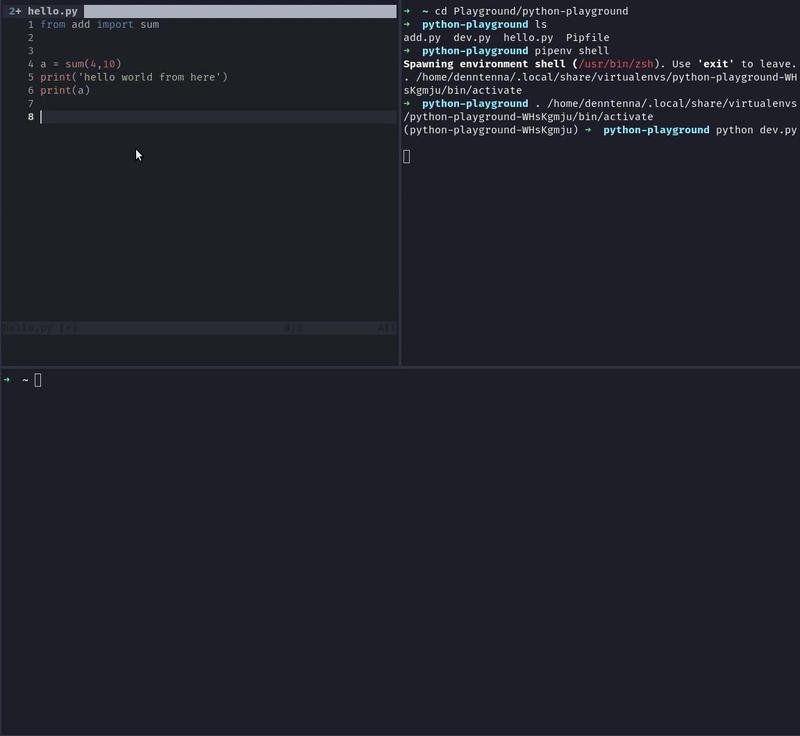Python
Footguns
- difference between
isand==
Tips and Tricks
- from time import sleep
- Open your current file in interactive mode to inspect/debug it
python -i file.py - String templating
print("%s : %s" % (name, age)) - Pipenv environments are stored in
~/.local/share/virtualenvs. Can be deleted as part of system cleanup
Lists
`a = [1, 2, 3]
Python now has tools inspired from haskell to operate with lists in the module itertools. Documentation is here
Use a list as stack
stack = [2,3,4]
stack.append(5)
stack.append(6)
stack.pop()
stack.pop()
Use a list as Queue
from collections import deque
queue = deque(["apple", "banana", "cat"])
queue.append("dog")
queue.append("elephant")
queue.popleft()
queue.popleft()
List Comprehensions a concise way to create list
A list comprehension consists of brackets containing an expression followed by a for clause, then zero or more for or if clauses. The result will be a new list resulting from evaluating the expression in the context of the for and if clauses which follow it.
List Display and Comprehension
a = [x*x for x in range(10)]
Generators
If your function uses the yield command, its a generator.
def natural_numbers():
i = 0
while True:
yield i
i ++
You can pass generators to functions as paramters by prefixing * to the parameter name - def fun(*gen)
Multiple ways to use iterators
- with a for loop
for num in natural_numbers:
print(num)
inline usage
value = sum(next(t) for n in slice(natural_numbers, 10))
Use yield without a value
Simply writing the command yield, yields control to the calling code.
- Convert a generator into a context manager
from contextlib import contextmanager
@contextmanager
def db_test(cur):
cur.execute('create table points(x int, y int)')
try:
yield
finally:
cur.execute('drop table points ')
Class
Special functions in a Class
__init__: constructor__repr__: print your class sensibly__add__: operator overload the + operator__iter__,__next__: make the class iterable- raise StopIteration()
__enter__,__exit__: make your class a ContextManger, with setup and teardown functions.
Internals
- see what happens in the python bytecode
from dis import dis
dis(function_name)
- inspect source code of a function in runtime
from inspect import getsource
getsource(add)
Ecosystem
- Eventlet brings concurrency to python
References
- So you want to be a python expert by James Powell
- Transforming Code into Beautiful Idiomatic Python by Raymond Hettinger
- Documentation for Collections
- An opinionated guide to python
Starting a new Python project
Pipenv for package management and virtual environment
Notes from Idiomatic Python
- ChainMap
- Clarify function calls with keyword arguments
- You are sacrificing performance but improving developer time
- named tuples
from collections import namedtuple
def named_tuples(a: int):
Results = namedtuple("Result", ["status", "payload"])
if a < 0:
return Results("error", {})
if a > 0:
return Results("success", {"number": a})
print(named_tuples(3))
print(named_tuples(-1))
- Updating Multiple state variables
- Decorators and Context Managers : Help separate business logic from administrative ones
Async
Notes from Keynote on Concurrency, PyBay 2017 Goal : When to use threads, processes, asyncs. Advantages and disadvantages
Functional Programming
Creating partial functions - documenttion
This reminds me of currying in haskell
def user(name, age, role):
return {"name":name, "age":age, "role":role}
manager = partial(user, role="manager")
admin = partial(user, role="admin")
print(user(name="denny", age="32", role="user"))
print(manager(name="denny", age="38"))
print(admin(name="denny", age=42))
Pattern and Matching
https://peps.python.org/pep-0636/ How to implement delegation using pattern matching
Requires python 3.10+
action_pass = {"type": "pass", "payload": {"name": "denny"}}
action_keep = {"type": "keep", "payload": {}}
action = action_pass
match action:
case {type, payload}:
print(type)
Live Development Process with Reload
Uses the inotify syscall on linux to trigger reload of the program upon file changes

import inotify.adapters
import subprocess
def watch():
i = inotify.adapters.Inotify()
i.add_watch('./')
for event in i.event_gen(yield_nones=False):
(_, type_names, path, filename) = event
#print("PATH=[{}] FILENAME=[{}] EVENT_TYPES=[{}]".format(path,filename,type_names))
for type in type_names:
#print("type: {} path: {} filename: {}".format(type, path, filename))
if type == "IN_CLOSE_WRITE" and ".py" in filename:
print('reload file')
subprocess.run(["python", "hello.py"])
if __name__ == '__main__':
watch()
Numerical and Scientific Computing
import numpy as np
import plotly.express as px
x = np.linspace(-np.pi, np.pi, 50)
y = np.array([np.sin(i) for i in x])
fig = px.scatter(x=x, y=y)
fig.show()
SciPy, Pandas and OpenCV use numpy array as the common format for data exchange
